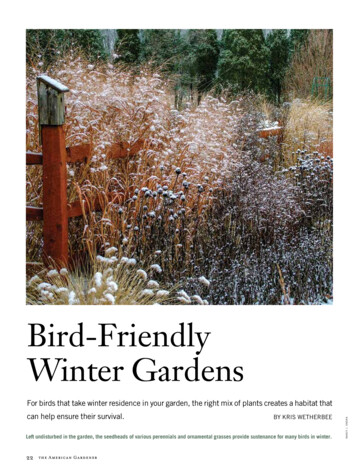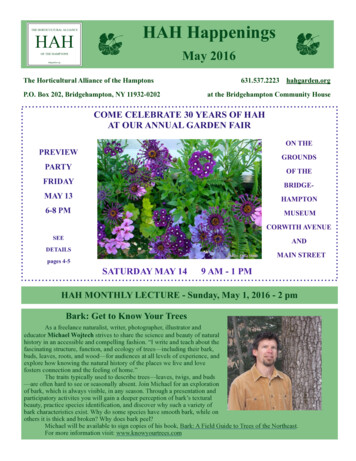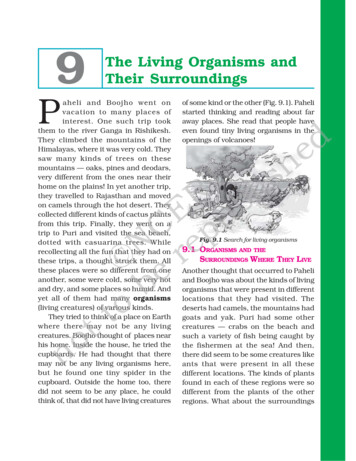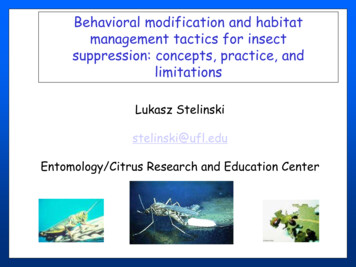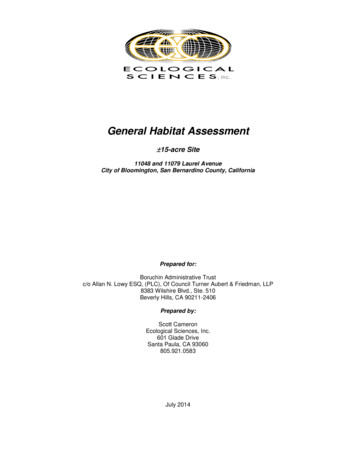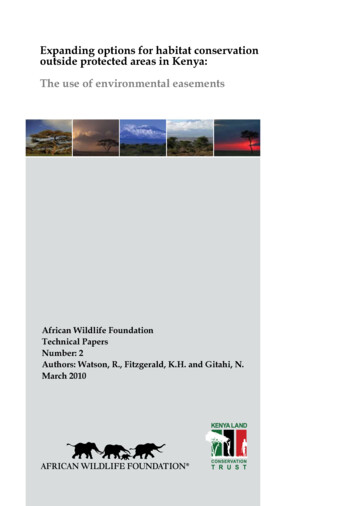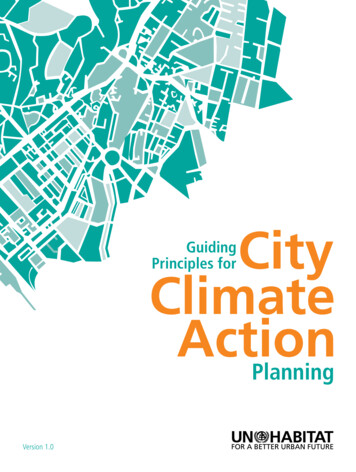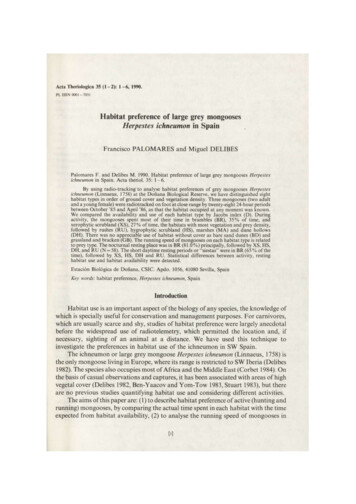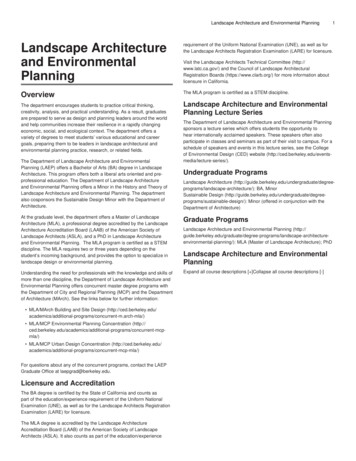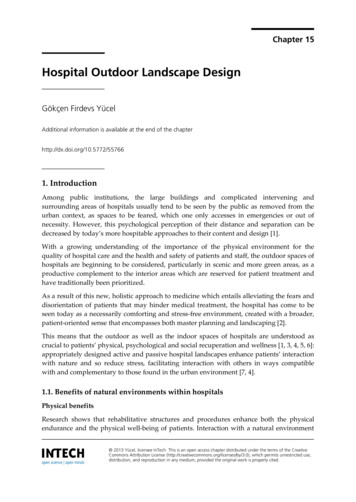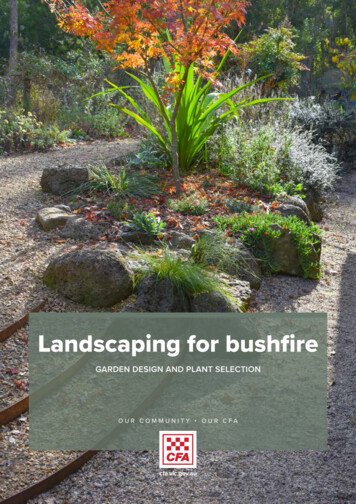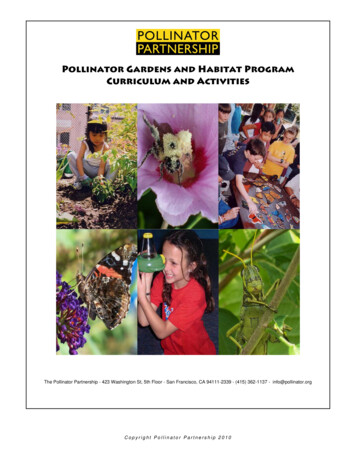
Transcription
Pollinator Gardens and Habitat ProgramCurriculum and ActivitiesThe Pollinator Partnership - 423 Washington St, 5th Floor - San Francisco, CA 94111-2339 - (415) 362-1137 - info@pollinator.orgCopyright Pollinator Partnership 2010
423 Washington St., 5th Fl.San Francisco, CA 94111t ear Teacher:Gardens are wonderful educational resources! P2 is pleased to provide thissupplemental curriculum packet as one way to enrich classroom education through abutterfly and pollinator garden. It includes exercises to expand on and enforce whatstudents have learned about butterfly and pollinator gardens, pollinators, other insects,their relatives and biodiversity.Included are: Lesson plans for activities relating to insects, ready to integrate into subject areasacross the elementary and middle school curriculum, including language arts, mathand science Extension ideas for home Background information for the teacher California State Content Standards correlationThe lessons are divided into levels, though any lesson may be adapted to a differentlevel should you deem it appropriate: pre-K/Kindergarten1st/2nd grade, (adaptable for 3rd-5th grades)3rd-5th grades6th-12th grades, (adaptable for 3rd-5th grades)We hope this curriculum packet will be useful to you and we appreciate any and allfeedback you may have. Please take 5 minutes to fill out and return the feedbackform included in the packet to:Pollinator Partnership423 Washington Street, 5th FloorSan Francisco, CA 94111Thank you for your invaluable support and encouragement for the P2 PollinatorGardening program! Teachers are our most valuable resources.Warm Regards,The Bug People at P2Copyright Pollinator Partnership 2010
TABLE OF CONTENTSP2 Pollinator Gardens and Habitat ProgramTeaching Guide Introduction and Essential BackgroundInformation (for Teachers)Supplementary Curriculum – Activities and LessonsCopyright Pollinator Partnership 2010
Pollinator Partnership’sPollinator Gardens and Habitat ProgramThe BUZZ about P2’s Pollinator Gardening Program started in 2000 with theestablishment of our first school garden at Charles Drew Elementary inBayview/Hunter’s Point. Since then, the Pollinator Partnership has createdimportant pocket habitats and unique outdoor classrooms in various settingsacross the San Francisco Bay Area. From local schools to senior centers,from hospice to community centers, Pollinator Gardens are an opportunity toenhance the urban habitat of people and pollinators while providing livinglaboratories for learning and exploring. Opportunities for learning abound as the seasons andinhabitants develop throughout the year.Working closely with teachers, students, administrators, neighbors and community members, as wellas a wide variety of local and national organizations, Pollinator Partnership creates usable gardenspaces for people and pollinators to share. Our gardens vary in size and complexity based on thegeography and resources of each school. P2 is also an active member of the San Francisco GreenSchool Alliance. Following is a list of gardens created through P2’s Gardening Program:2000 Charles Drew E.S., San Francisco2001 Visitation Valley M.S., San Francisco Tenderloin Community School, SanFrancisco Guadalupe School, San Francisco On Lok Senior Center, San Francisco Laguna Honda Hospice, San Francisco Chinatown Community Children’s Center,San Francisco Las Americas Childcare Center, SanFrancisco Alvarado E.S., San Francisco2002 Sun Shine Garden E.S., South San Francisco Leo J. Ryan C.D.C., South San Francisco Bryant E.S., San FranciscoFunding for Butterfly and Pollinator Gardening comesfrom a variety of sources including P2 Membershipand charitable donations from individuals, companiesand foundations.Pollinator Partnership423 Washington Street, 5th Fl.San Francisco, CA 94111(415) 362-1137fax (415) 362-3070info@pollinator.orgwww.pollinator.org St. Francis Pre School, NovatoThe Jewish Home, San FranciscoSt. Anne’s Home, San FranciscoNob Hill Health Care Center, San FranciscoWalden Hills Boys Group Home, SanFrancisco Marin Academy, San Rafael2003st 21 Century Academy, San Francisco Randall Museum, San Francisco Oakland Zoo Education Area2004 Eden Housing/Fuller Gardens, San Leandro San Mateo Medical CenterComing Soon Haven C.D.C., Menlo Park
TEACHING GUIDE INTRODUCTIONThe overriding theme of the curriculum is to instill in the young generationcuriosity, amazement and caring for pollinators of all kinds. These creatures areessential components to every ecosystem on earth and play a vital role inensuring a plentiful food source for humanity. The Pollinator Partnershipencourages the young generation to become stewards for pollinators and allbiodiversity protection.The material in this packet offers exercises to introduce and expand on topicsrelated to butterfly and pollinator gardening, including: How to maintain and get the most out of a pollinator garden throughecologically friendly practices Physical and social attributes of butterflies and other pollinators The importance of these creatures in the production of food and otherplant products common in everyday use The vital role organisms such as insects play in ecosystemsCopyright Pollinator Partnership 2010
Pollinator Gardens Supplemental Curriculum:ESSENTIAL INFORMATION FOR TEACHERSInsect and Pollinator InformationANATOMY Insects (including butterflies, flies, beetles, bees, dragonflies, ants, andmany others) are characterized by six (6) legs, three (3) body parts [HEAD,THORAX, and ABDOMEN], a hard EXOSKELETON and COMPOUND EYES. Mostinsects have a pair of ANTENNAE and two (2) pairs of wings.Spiders are NOT insects, but like insects and are ARTHROPODS (jointed legs, hardouter layer). They have eight (8) legs, compound eyes, an exoskeleton and two (2)body parts [HEAD and CEPHALOTHORAX]. Some spiders have URTICATINGHAIRS which they will throw at a predator when attacked. This defense stings thepredator’s eyes and temporarily blinds it.Insects grow by MOLTING, shedding their old exoskeleton and growing a new, largerone. When they have just molted, and before the new exoskeleton hardens, insectbodies are soft and vulnerable.Insects also go through COMPLETE METAMORPHOSIS. Life cycle stages are EGG,LARVA, PUPA and ADULT. Butterflies, bees and beetles are insects whose larvalforms are distinctly different from the adult form. Insects whose larval form resemblesthe adult go through INCOMPLETE METAMORPHOSIS. Crickets and cockroachesgo through incomplete metamorphosis.BEHAVIOR Insects can be herbivorous or carnivorous. Some insects are pests tohumans: mosquitoes feed on mammalian blood, aphids and scale insects infest ourgardens and wasps produce a nasty sting.But many more insects are incredibly beneficial to humans: bees, beetles andbutterflies pollinate our gardens and crops, making possible such foods as chocolate,honey, nuts and most fruits; some insects are decomposers, helping to breakdowndead material; and other insects, like ladybugs and praying mantis, feed on pestinsects. Even mosquitoes and many other insects are food for other animals.Flowers have adapted various attributes (color, scent, shape, size) to attract certainpollinators such as bees, butterflies and hummingbirds. These pollinators sip sweetnectar from the flower, collect pollen and carry this pollen to the next flower of thesame species (or in some cases, the pollinator moves the pollen within the sameflower), thus fertilizing the flower.Vocabulary Adapt – To grow and change in response to environmental conditions. Adaptation – Special body features or behaviors that help a creature survive in itsenvironment. Biodiversity – The diverse variety of life forms: the different plants, animals andmicro-organisms; and the Eco-systems they form. Usually considered at three levels:genetic diversity, species diversity and ecosystem diversity. Carnivores or Secondary Consumers – These animals don’t eat plants, but feed
on animals that do eat plants. Decomposer – An animal that breaks down dead or decomposing plant materials,thus recycling important nutrients and returning them to the environment. Ecosystem – A dynamic system of plant, animal and micro-organism communitiesand non-living components interacting as an ecological unit. Endangered – Animal or plant species in danger of extinction throughout all or asignificant portion of their range due to one or more causes, including loss of habitat,over-exploitation, competition or disease. Environment – The complex web of inter-relationships between living organismsand non-living components, which sustain all life on earth. Fauna – All of the animals found in a given area. Flora – All of the plants found in a given area. Food Web – A group of interlinked food chains. In addition to herbivores,omnivores and carnivores, the food web also contains scavengers and decomposers,so that no available source of energy is ever allowed to go to waste. Habitat – A place where an animal or plant lives which provides food, water,shelter and space for survival. Herbivores or Primary Consumers – Animals that eat primarily plants. Metamorphosis – The process of change from young to adult in which the youngis very different from the adult. Migration – The seasonal, usually two-way and goal-oriented movement from oneplace or habitat to another to avoid unfavorable climatic conditions and/or to seekmore favorable energetic conditions. Native – Indigenous to and dwelling within a specific area for an entire lifespan. Nectar – A sugary fluid produced by flowers to attract animal pollinators. Petals – Colorful flower parts that surround the floral reproductive structures. Pistil – The name for the collective female floral reproductive parts including thestigma, style and ovary. Pollen – A collective name for pollen grains. Pollen bears sperm for plantreproduction. Pollen Tube – Tube formed after germination of the pollen grain. It carries themale reproductive information to the ovule. Pollinated – The condition of the flower in which the female parts of a flower havereceived pollen transferred from the male parts of the same flower, or another flowerof the same species, resulting in the production of seeds and fruits. Pollination – The spreading of pollen from the male parts to the female parts of aflower of the same species, resulting in the production of seeds and fruits. Pollinator – An animal that carries pollen from the male parts of flowers to thefemale parts, fertilizing plant “eggs” with plant “sperm.” Primary Producers – All food chains begin in green plants (“primary producers”)with a process called photosynthesis. Energy from the sun lands on plants and iscollected by chlorophyll. With this energy plants can then make sugar and oxygen,food for other animals. Seed – The part of the fruit of a plant which is capable of growing (germinating)and producing a new plant. Stamen – The name for the collective male floral reproductive parts, including theanthers and filaments. Threatened – Species, subspecies or varieties likely to become endangered withinthe foreseeable future throughout all or a significant portion of their range, withoutspecial protection and management efforts.
SubjectScienceSciencePollinator Gardens Supplemental CurriculumOVERVIEW OF ACTIVITIESLessons and Activities ActivityAge LevelLesson ObjectiveSheetsIncludedStudents will begin to understand the nature of biodiversity byYes1st/2nd and The Food Webbuilding a food web. They will observe how all living things are(gamehigherconnected within an ecosystem.cards) Pollinator HabitatsYes,Also: TheHabitatSong1st/2nd andhigherStudents will understand that habitats satisfy animal needs. Peopleand animals (specifically pollinators) have similar basic needs,including: shelter, food, water and warmth. Students will explore thegarden to see how it is meeting the habitat needs of pollinators.Students will understand that habitats satisfy animal needs. Peopleand animals (specifically pollinators) have similar basic needs,including: shelter, food, water and warmth. Students will explore thegarden to see how it is meeting the habitat needs of pollinators.Students will learn the basics behind non-toxic pest control. They willbe able to name and recognize a few beneficial insects, as well assome common garden pests. And students will explore how to makethe garden more appealing to beneficial insects while discouragingpests.Students will understand that insects can be categorized by thedifferent type of mouthparts that they have. The mouthpart gives usclues to what and how the insect eats.Students will practice identification and investigation skills whilesearching for specific garden features such as plant parts andanimals.Use insects to practice listening, reading and writing skills.Science Pollinator Needs:Who NeedsPollinators?3rd-5th, 6th-8thScience What Can We Doabout GardenPests?1st/2nd, 3rd-5thScience My MunchingMouthparts1st/2nd, 3rd-5thScience Garden ScavengerHuntYes1st/2nd, 3rd-5thLanguage Arts YesLanguage Arts My Garden BugBookPretendPollinatorsPre-K/K,1st/2nd1st/2nd, 3rd-5th Use knowledge of local pollinators including their role in the garden,habitat and eating habits, to create an imaginary pollinator. Write aand higherYesrdthththLanguage Arts Dear Pollinator (orDear Neighbor)3 -5 , 6 -8and higherLanguage Arts 1st/2nd, 3rd-5thLanguage Arts PollinatorAlphabet BookBug PuzzlesYes (2levels ofdifficulty)story about the creature.Students will practice letter composition and point of view writing.Using knowledge of pollinators and their needs, write a letter to apollinator expressing the benefits of the garden and inviting it to visit.Or write a letter to a garden neighbor, from a pollinator’s point ofview, expressing the need to take care of the garden.As a class, students will produce a pollinator alphabet book.1st/2nd, 3rd-5th Review insect vocabulary and facts through various language artsgames and puzzles.
Pollinator Gardens Supplemental CurriculumOVERVIEW OF ACTIVITIESUse concrete images of insects, insect relatives and flowers in mathYesPre-K/KGarden Mathproblems.(Pre-K/K)Math Math Garden Math(1st/2nd)Math Buggy GardenMath SheetsMath Pre-K/KLanguage Arts My Garden BugBookMath Garden Math Buggy Garden MathSheetsYesYes (21st/2ndPre-K, 1st/2nd Use insects, spiders and other familiar animals in concrete mathproblems, while reviewing numbers of body parts. Students will beable to distinguish between insects and insect relatives.sheets foreach agegroup)YesBuggy WordProblemsUse concrete images of insects, insect relatives and flowers inmath problems.1st/2nd, 3rd-5th To practice attentive listening skills and apply them to mathwords problems. Use insects, spiders and other familiaranimals to create and solve word problems.1st/2ndScience The Food Web Pollinator Habitats What can we do about Garden Pests? My Munching Mouthparts Garden Scavenger Hunt Seed StudyLanguage Arts My Garden Bug Book Pretend Pollinators Bug Puzzles Pollinator Alphabet BookMath Garden Math Buggy Garden Math Sheets Buggy Word Problems3rd-5thScience The Food Web Pollinator Habitats Pollinator Needs What can we do about Garden Pests? My Munching Mouthparts Garden Scavenger Hunt Seed StudyLanguage Arts Pretend Pollinators Bug Puzzles Dear Pollinator Pollinator Alphabet BookMath Buggy Word Problems6th-8th and higherScience The Food Web Pollinator Habitats Pollinator NeedsLanguage Arts Pretend Pollinators Dear Pollinator
Pollinator Gardening Supplemental Curriculum: ScienceLevel: 1st/2nd and higher gradesTHE FOOD WEBObjective: Students will begin tounderstand the nature of biodiversity bybuilding a food web. They will observe howall living things are connected within anecosystem.1. Each student will get an animal orplant card. The card will say whatthis organism eats/needs to surviveand what eats/preys upon theorganism.Materials: large open area in which to buildthe web, animal and plant cards (1perstudent, pictures and facts included, gluethese to index cards), 1-2 large balls of yarnor other string2. Review the rules of the game: do notpull on the string, do not let go of thestring unless the teacher tells you to.Hold onto your own card, and hold itso that everyone can see whatorganism you are.Vocabulary to review: ecosystem,biodiversity, food web, predator, prey,habitat, decomposers (recyclers), nutrients,population, endangered, extinctProcedure:-- Introduce the idea of ecosystem andbiodiversity. All living things are connectedwithin an ecosystem.-- Ask for examples of predator/preyrelationships in an ecosystem (ie.bird/spider, spider/ladybug, ladybug/aphid,aphid/flower, flower/dirt, dirt/dead bird).-- Talk about how some things in theecosystem eat the waste products of otherthings (worms, millipedes eat rottingvegetable matter, scavengers eat deadanimals), which in turn ends up back in thesoil in the form of nutrients for plants. Thereis no waste in nature!3. Choose one student to start. She willread her card, saying what organismshe is, and what she eats. Holdingonto the end of the string, she willpass the remaining string to one ofher “prey” (an organism she eats).4. The next student (the “prey”) will dothe same: read their card, hold thestring and pass the remaining stringonto a “prey”. There are now 3students connected by the string.Note: With younger students, theteacher may want to pass the string forthe students.-- Build a class food web.Food Web – A group ofinterlinked food chains. In addition toherbivores, omnivores and carnivores,the food web also contains scavengersand decomposers, so that no availablesource of energy is ever allowed to go towaste.CA Science Content Standards: Life Sciences 2 [plants and animals meet their needs indifferent ways, and have predictable life cycles], Experimentation 4 [make predictions based onobserved patterns].P o l li na tor G ar d en ing i s a p r ogr am o f t he non - pr o f i t Po ll i na to r P ar tn er s h ip , a c a t alys tfor b iod ivers i ty s tewar dsh ip .P2 : (415 ) 362-1137www.po llina tor.orgin fo@po llina tor.org
Pollinator Gardening Supplemental Curriculum: ScienceLevel: 1st/2nd and higher gradesTHE FOOD WEB (continued)5. Continue to pass the string until allstudents are connected by the “foodweb,” many will be connected morethan once. Discuss what thestudents see as they look at theweb. (With younger students, thiscan be the end of the activity.)Extension 1:-- Demonstrate how all living things are connected in the ecosystem, and what happens if anorganism is endangered or goes extinct. Read an ecosystem scenario (included, or make upyour own), about one organism that dies out (ex. grasshopper).-- The “grasshopper” student will let go of the string at their point. Animals that eat thegrasshopper will lose a food source. If this is their only food, they will die. They drop the string.Continue with the chain of reactions.-- What does the web look like without some of these organisms? Discuss how organisms areconnected within the ecosystem.Extension 2: Have students write about or draw a food web.CA Science Content Standards: Life Sciences 2 [plants and animals meet their needs indifferent ways, and have predictable life cycles], Experimentation 4 [make predictions based onobserved patterns].P o l li na tor G ar d en ing i s a p r ogr am o f t he non - pr o f i t Po ll i na to r P ar tn er s h ip , a c a t alys tfor b iod ivers i ty s tewar dsh ip .P2 : (415 ) 362-1137www.po llina tor.orgin fo@po llina tor.org
Pollinator Partnership: The Food Web game cards—Paste individual cards onto index cards.ButterflyEats: Poppy nectar Fruit (apples,bananas)WormEats: Fruit(apples, bananas) GrassProduces: CompostCockroachesEat: FruitCompostCaliforniaPoppy (nectar)Needs: Nutrientsfrom the soil(Compost) WaterFoxEats: Hawk Mouse Tarantula Butterfly BerryMosquitoEats blood from: Deer Raccoon Rabbit Mouse
Pollinator Partnership: The Food Web game cards—Paste individual cards onto index cards.DeerEats: Poppy WildRose GrassLadybugEats: AphidWild RoseNeeds: Nutrientsfrom the soil(Compost) WaterPrayingMantisEats: Aphid CaliforniaNative GrassNeeds: Nutrientsfrom the soil(Compost) WaterGrasshopperTarantulaEats: Mouse Cockroach Worm Butterfly Grasshopper
Pollinator Partnership: The Food Web game cards—Paste individual cards onto index cards.BeeEats: Nectarfrom:poppy, wild rose, berryProduces: HoneyAphidEats: Wild Roseleaves Poppy Berry leavesRaccoonMillipedeEats: Grass Compost Fruit(apples, bananas)Produces: CompostEats: PrayingMantis Millipede Butterfly Berry Cockroach Worm FruitGrasshopperHawkEats: Fruit GrassEats: Mouse Butterfly Spider
Pollinator Partnership: The Food Web game cards—Paste individual cards onto index cards.BearEats: Fox Hawk Mouse Berry HoneyCaliforniaBlackberryNeeds: Nutrientsfrom the soil (Compost)MouseEats: Berry Fruit GrassCompost(dirt)Compost(dirt)When these thingsdie, they decomposeand “feed” the dirt:When these thingsdie, they decomposeand “feed” the dirt: All animals: bear, raccoon,mouse, hawk, deer, millipede All insects: bee, praying All animals: bear, raccoon,mouse, hawk, deer, millipede All insects: bee, prayingmantis, butterfly, aphidmantis, butterfly, aphid All plants: berry, grass,poppy, roseAll plants: berry, grass,poppy, rose
Pollinator Gardening Supplemental Curriculum: ScienceLevel: 1st/2nd and higherPOLLINATOR HABITATSObjective: Students will understand thathabitats satisfy animal needs. People andanimals (specifically pollinators) havesimilar basic needs, including: shelter, food,water and warmth. Students will explore thegarden to see how it is meeting the habitatneeds of pollinators.Location: Start inside, move to the gardenMaterials: (optional) pictures of variousthings found in a people habitat (ex: clothes,water, roller skates, food, sun, radio, car),large dry erase board/ poster paper withmarkers, map-making materials (crayons,pencil, paper, ruler)Vocabulary and ideas to review: Habitat,pollinator, flower, nectar, pollen, flowerparts, shelter, ecosystemProcedure:1. Discuss people and animal needs.-- Have students look at pictures of variousobjects (or write words on the board—seematerials list for ideas).-- Ask: Which things do people NEED tolive? What can people live without?[hint: Direct students to go beyond “I needa video game to live.”].--Things people NEED to live should fit intothese categories:1. Shelter/protection- a place to live,doors, clothes-to protect us from weather;2. Food;3. Water;4. Warmth-sunshine and light.-- How about animals? What do they NEEDto survive?Probably some of the same things thatpeople need! Shelter, Food, Water andWarmth.A good habitat provides for all of theseNEEDS for its inhabitants.-- What animals live in the garden?Introduce/review the idea that many animalshere are pollinators, like bees, butterflies,hummingbirds, beetles and other bugs.2. Explore the garden habitat. As aclass, explore the garden for ways that itmeets the needs of pollinators. Ask:-Do you see any pollinators? If not, wheredo you think they are?-Is there water nearby?-Where could pollinators hide? Is it safehere? What would make it safer forpollinators?-What can they eat here?-How does the garden provide forwarmth? Is there sun?3. Students will use the Garden Habitatactivity sheet to look for things that makethe garden a good habitat for a specificpollinator.--Students should choose a pollinator thatthey have seen in the garden. Use theGarden Habitat sheet to draw or write howthe garden meets the needs of THEIRpollinator.CA Science Content Standards: (1st, 2nd) Life Sciences 2 [Predictable life cycles: plants andanimals meet their needs in different ways, inhabit different environments, need water food and light],Experimentation 4 [make predictions based on observed patterns, record observations, describerelative positions of objects, follow oral instructions].(3rd, 4th) Life Sciences a,c,d (3rd) and 2a-c & 3a-c (4th) [adaptations in structure improve chance forsurvival: different structures, organisms can change their environment which has effects on otherorganisms, ecosystems have living and non-living parts, animals and plants are dependent upon eachother], Earth Sciences 4 [the sun changes position throughout the day]P o l li na tor G ar d en ing i s a p r ogr am o f t he non - pr o f i t Po ll i na to r P ar tn er s h ip , a c a t alys tfor b iod ivers i ty s tewar dsh ip .P2 : (415 ) 362-1137www.po llina tor.orgin fo@po llina tor.org
Pollinator Gardening Supplemental Curriculum: ScienceLevel: 1st/2nd and higherPOLLINATOR HABITATS (continued)Language Arts Extension:Create an ad directed toward your pollinator, telling it why the garden is a good habitat for it.Geography Extension:Have students draw a map of the garden, showing garden features that are designed to provideShelter, food, water and warmth.Music Extension:Listen to or sing “Habitat Song” by Bill Oliver (words included with activity sheets)CA Science Content Standards: (1st, 2nd) Life Sciences 2 [Predictable life cycles: plants andanimals meet their needs in different ways, inhabit different environments, need water food and light],Experimentation 4 [make predictions based on observed patterns, record observations, describerelative positions of objects, follow oral instructions].(3rd, 4th) Life Sciences a,c,d (3rd) and 2a-c & 3a-c (4th) [adaptations in structure improve chance forsurvival: different structures, organisms can change their environment which has effects on otherorganisms, ecosystems have living and non-living parts, animals and plants are dependent upon eachother], Earth Sciences 4 [the sun changes position throughout the day]P o l li na tor G ar d en ing i s a p r ogr am o f t he non - pr o f i t Po ll i na to r P ar tn er s h ip , a c a t alys tfor b iod ivers i ty s tewar dsh ip .P2 : (415 ) 362-1137www.po llina tor.orgin fo@po llina tor.org
Habitat (Have to Have a Habitat)[printed with permission]by Bill Oliver, from the album Have to Have a Habitat(loosely follows the tune and beat of the 1960’s "Lollipop.”)(chorus) Habitat, habitat, have to have a habitatHabitat, habitat, have to have a habitatHabitat, habitat, have to have a habitat.You have to have a habitat to carry on!(chorus)1 The ocean is a habitat,a very special habitatit's where the deepest waters atit's where the biggest mammal's atit's where our future food is atit keeps the atmosphere intact.The ocean is a habitat that we dependon.(chorus)2 The forest is a habitat,a very special habitatit’s where the tallest trees are atit's where a bear can scratch her back(ch-ch-ch-ch-ch-ch-ch)it keeps the ground from rolling backrenews the oxygen in fact.The forest is a habitat that we dependon.3 The river is a habitat,a very special habitatit's where the freshest water's atfor people, fish and muskratbut when the people dump their trashthe river takes the biggest rap.The river is a habitat that we dependon.(chorus)4 People are different than foxes andrabbitsEffect the whole world with their badhabitsBetter to love it while we still have itOr rat ta-tat-tat, our habitat's gone(chorus)(chorus)Bill Oliver, “Mr. Habitat,” writes and performs environmental songs forchildren and adults across the United States. He is available for schoolperformances. His music (sample MP3s and CDs) and lyrics areavailable at www.MrHabitat.netOther contact information:MrHabitat@aol.com(512) 477-7227(800) 492-1520
Name:Pollinator PartnershipGarden Habitats Activity SheetWhat is your pollinator?How does the garden give SHELTER, FOOD, WATER and WARMTH toyour pollinator? Draw or write about what you find.SHELTERFOODWATERWARMTHIs this garden a good HABITAT for your pollinator?
Pollinator Gardening Supplemental Curriculum: ScienceLevel: 3rd-5th , 6th-8th and higherPOLLINATOR NEEDS: WHO NEEDS POLLINATORS?Objective: Students will understand thathabitats satisfy plant and animal needs.People and animals (specifically pollinators)have similar basic needs, including: shelter,food, water and warmth. Students willexplore the garden to see how it is meetingthe habitat needs of pollinators.Location: Start inside, move into thegarden-- How about animals? What do they NEEDto survive?Probably some of the same things thatpeople need!Create a third list on a separate sheet ofpaper.Be sure to emphasize Shelter, Food,Water and Warmth.A good habitat provides for all of theseNEEDS for its inhabitants.Materials: large dry erase board/ posterpaper with markers, access to a buildingwith roof, door, windows, water, kitchen,(optional: snacks)-- What animals live in the garden?Introduce/review the idea that many animalshere are pollinators.Vocabulary and ideas to review: Habitat,Needs v. Wants (how are these similar?different?), pollinator, flower, nectar, pollen,fertilization, flower parts (petal, stamen,pistil), ecosystem2. Explore the garden. Students shouldsearch for specific ways in which the gardensatisfies the NEEDS of pollinators.Procedure:1. Discuss Needs.-- Ask: What are things that people NEED tosurvive?[hint: Direct students to go beyond “I want avideo game.”]. Start a list on the board.--Things people NEED to live should fit intothese categories:1. Shelter/protection- a place to live,doors, clothes-to protect us from weather;2. Food;3. Water;4. Warmth-sunshine and light.Write these and students’ ideas on theboard.-- Students should be given a list ofquestions to explore/answer in the garden.Think about the NEEDS of pollinators. Howdoes this garden meet those needs:-Do you see any pollinators? If not, wheredo you think they are?-Is there water nearby?-Where could pollinators hide? Is it safehere? What would make it safer forpollinators?-What can they eat here?-How does the garden provide for warmth?Is there sun?-- Students may sketch what they fin
Pollinator Partnership’s . Pollinator Gardens and Habitat Program . The BUZZ about P2’s Pollinator Gardening Program started in 2000 with the establishment of our first school garden
